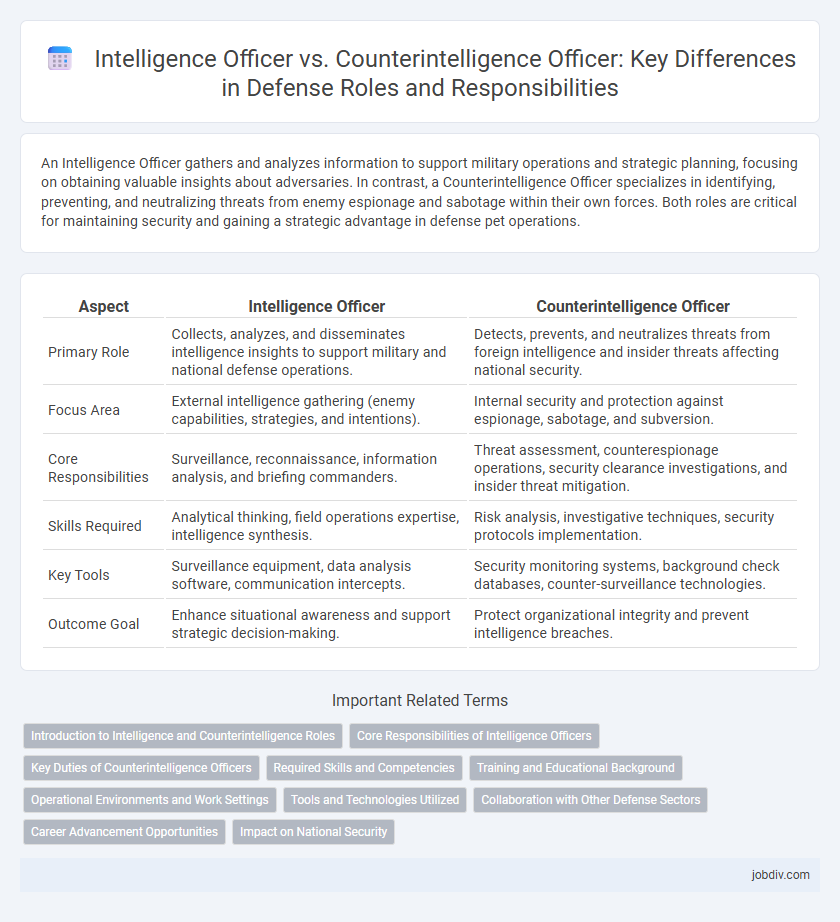An Intelligence Officer gathers and analyzes information to support military operations and strategic planning, focusing on obtaining valuable insights about adversaries. In contrast, a Counterintelligence Officer specializes in identifying, preventing, and neutralizing threats from enemy espionage and sabotage within their own forces. Both roles are critical for maintaining security and gaining a strategic advantage in defense pet operations.
Table of Comparison
| Aspect | Intelligence Officer | Counterintelligence Officer |
|---|---|---|
| Primary Role | Collects, analyzes, and disseminates intelligence insights to support military and national defense operations. | Detects, prevents, and neutralizes threats from foreign intelligence and insider threats affecting national security. |
| Focus Area | External intelligence gathering (enemy capabilities, strategies, and intentions). | Internal security and protection against espionage, sabotage, and subversion. |
| Core Responsibilities | Surveillance, reconnaissance, information analysis, and briefing commanders. | Threat assessment, counterespionage operations, security clearance investigations, and insider threat mitigation. |
| Skills Required | Analytical thinking, field operations expertise, intelligence synthesis. | Risk analysis, investigative techniques, security protocols implementation. |
| Key Tools | Surveillance equipment, data analysis software, communication intercepts. | Security monitoring systems, background check databases, counter-surveillance technologies. |
| Outcome Goal | Enhance situational awareness and support strategic decision-making. | Protect organizational integrity and prevent intelligence breaches. |
Introduction to Intelligence and Counterintelligence Roles
Intelligence Officers gather, analyze, and disseminate information critical to national security, focusing on foreign threats and enemy capabilities. Counterintelligence Officers specialize in detecting, preventing, and neutralizing espionage, insider threats, and sabotage within their own organizations. Both roles ensure operational effectiveness through distinct but complementary functions in protecting sensitive information and national defense interests.
Core Responsibilities of Intelligence Officers
Intelligence Officers primarily collect, analyze, and disseminate information regarding foreign threats, enabling strategic decision-making and mission planning. They focus on gathering human intelligence (HUMINT), signals intelligence (SIGINT), and geospatial intelligence (GEOINT) to provide actionable insights. Their role includes assessing enemy capabilities, intentions, and vulnerabilities to support operational and national security objectives.
Key Duties of Counterintelligence Officers
Counterintelligence Officers are primarily responsible for identifying, assessing, and neutralizing threats from foreign intelligence services, preventing espionage, sabotage, and subversion against military and governmental assets. They conduct thorough background checks, monitor suspicious activities, and coordinate with other security agencies to protect sensitive information and maintain operational security. Their duties also involve analyzing intelligence reports and implementing countermeasures to safeguard national defense infrastructure from insider threats and cyber espionage.
Required Skills and Competencies
Intelligence Officers require strong analytical skills, proficiency in data collection and interpretation, and expertise in threat assessment to provide actionable intelligence. Counterintelligence Officers demand advanced investigative abilities, knowledge of security protocols, and a keen aptitude for detecting and neutralizing espionage and insider threats. Both roles emphasize critical thinking, discretion, and effective communication but diverge in focus on external intelligence gathering versus internal security measures.
Training and Educational Background
Intelligence Officers typically undergo rigorous training in intelligence analysis, surveillance techniques, and data interpretation, often holding degrees in political science, international relations, or cybersecurity. Counterintelligence Officers receive specialized education in identifying and mitigating espionage threats, mastering tradecraft, and conducting counter-surveillance, frequently supported by backgrounds in criminal justice, psychology, or security studies. Both roles require continuous professional development through military academies or intelligence agencies to stay updated on evolving security challenges and technologies.
Operational Environments and Work Settings
Intelligence Officers primarily operate in diverse environments such as military bases, field operations, and cyber domains, focusing on gathering, analyzing, and interpreting information to support strategic and tactical decisions. Counterintelligence Officers work in similar settings but concentrate on identifying and neutralizing threats from espionage, sabotage, and insider risks, often collaborating closely with law enforcement and security agencies. Both roles demand adaptability to dynamic operational environments, including hostile territories, secure headquarters, and digital networks.
Tools and Technologies Utilized
Intelligence officers utilize advanced data analytics platforms, satellite imagery, and signal interception technologies to gather and analyze information from diverse sources. Counterintelligence officers employ sophisticated cyber forensics, surveillance systems, and insider threat detection tools to identify and neutralize espionage threats. Both roles leverage artificial intelligence and machine learning algorithms to enhance threat assessment accuracy and operational efficiency.
Collaboration with Other Defense Sectors
Intelligence Officers and Counterintelligence Officers collaborate closely with other defense sectors to enhance national security by sharing critical information and threat assessments. Intelligence Officers gather and analyze data from multiple sources, facilitating informed decision-making across military branches and allied agencies. Counterintelligence Officers focus on protecting sensitive information and detecting insider threats, working alongside cybersecurity teams and law enforcement to ensure operational integrity and prevent espionage.
Career Advancement Opportunities
Intelligence Officers typically advance by gaining expertise in data analysis, strategic planning, and operational leadership, often moving into senior roles within national security agencies or military commands. Counterintelligence Officers progress by specializing in detecting and thwarting espionage activities, with career growth opportunities including leadership positions in security clearance programs and cyber counterintelligence units. Both career paths offer advancement through certifications, specialized training, and cross-agency collaboration, critical for higher-level assignments and executive roles.
Impact on National Security
Intelligence officers collect and analyze critical information to anticipate threats, enabling proactive defense strategies that enhance national security. Counterintelligence officers focus on identifying and neutralizing espionage, sabotage, and insider threats, preventing adversaries from compromising sensitive operations and classified information. Both roles are essential in maintaining a robust security posture, protecting against foreign intelligence services, and safeguarding national interests.
Intelligence Officer vs Counterintelligence Officer Infographic

 jobdiv.com
jobdiv.com